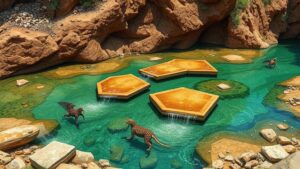Leveraging Local Markets: Selling Fossils and Gems in Regional Retail Outlets
Leveraging Local Markets: Selling Fossils and Gems in Regional Retail Outlets
For rockhounds and mineral collectors, the thrill of discovering unique specimens goes hand in hand with the excitement of selling these treasures. Whether it is a rare trilobite fossil or a dazzling amethyst geode, the potential to turn these findings into profit can be significant. This article explores the avenues available for selling fossils and gems in regional retail outlets, providing both new and seasoned collectors with actionable insights.
Understanding Your Market
Before venturing into the retail world, collectors must first understand the dynamics of their local market. Regional markets vary widely based on local geology, tourism levels, and consumer interests. Collectors should consider the following:
- Geological Richness: Areas with a rich geological history often attract tourists and collectors alike, increasing interest in local fossils and gems.
- Demographic Preferences: Knowing your audience–whether they are families, hobbyists, or serious collectors–can guide your inventory choices.
- Competition: Assess the current market by visiting existing shops and evaluating their offerings, pricing, and customer interactions.
According to the United States Geological Survey, certain regions, such as the Rocky Mountains and the Appalachian region, have significant mineral diversity that can enhance sales opportunities.
Curating Your Inventory
Choosing the right fossils and gems to sell is crucial. Collectors should focus on specimens that not only appeal to local interests but also stand out in quality and rarity. Here are several strategies to consider:
- Local Specimens: Highlight fossils or gems that are native to the region. Local connections enhance customer interest and sales potential.
- Unique Pieces: Seek out rare specimens, such as fossilized dinosaur bones or gem-quality minerals. These items often command higher prices in retail settings.
- Educational Value: Include information about each piece, such as its geological significance, age, and sifting process, as this can add intrinsic value and attract buyers.
Partnerships with Retail Outlets
Developing relationships with local retailers can significantly expand your reach. Consider the following approaches:
- Consignment Arrangements: Many local shops may be open to selling your fossils and gems on a consignment basis. This allows retailers to showcase your products without investment risk.
- Collaboration with Museums: Local museums often have gift shops that cater to visitors interested in geology and paleontology. Partnering with them can enhance exposure and sales.
- Events and Markets: Participate in local craft fairs, farmers’ markets, or geological expos, where you can showcase your collection directly to consumers.
Marketing Your Fossils and Gems
Effective marketing strategies can elevate your sales and visibility in the local market. Here’s how to make your products stand out:
- Social Media Engagement: Use platforms like Instagram and Facebook to showcase your collection. High-quality images and engaging stories can attract a wider audience.
- Educational Workshops: Hosting workshops on fossil identification or gemology can draw in prospective buyers while establishing you as an expert in the field.
- Referral Programs: Encourage satisfied customers to bring in new clients by offering discounts or small freebies for referrals.
Pricing Strategies
Setting the right price for your fossils and gems is a critical factor for success. It is essential to balance competitive pricing with your financial goals. Here are some tips:
- Research Market Prices: Investigate the pricing of similar specimens on platforms like eBay, Etsy, or specialized gem and mineral shows to establish a benchmark for your prices.
- Cost-Plus Method: Factor in your acquisition cost, any necessary restoration, and retail mark-up when determining prices.
- Discounts for Bulk Purchases: Offer competitive discounts to customers buying multiple items, promoting higher sales volumes meanwhile maintaining profit margins.
Conclusion
Selling fossils and gems in regional retail outlets can be a rewarding venture for rockhounds and mineral collectors. By understanding your market, curating quality inventory, building strategic partnerships, employing effective marketing, and implementing suitable pricing strategies, you can successfully tap into the local demand for geological wonders. As with any business, adaptability and continuous learning will enhance your potential for growth in this niche market.
Take action today by exploring local shops, gathering specimens, and engaging with your target audience. With dedication, you can make your mark as a local expert in the fascinating world of fossils and gems.


